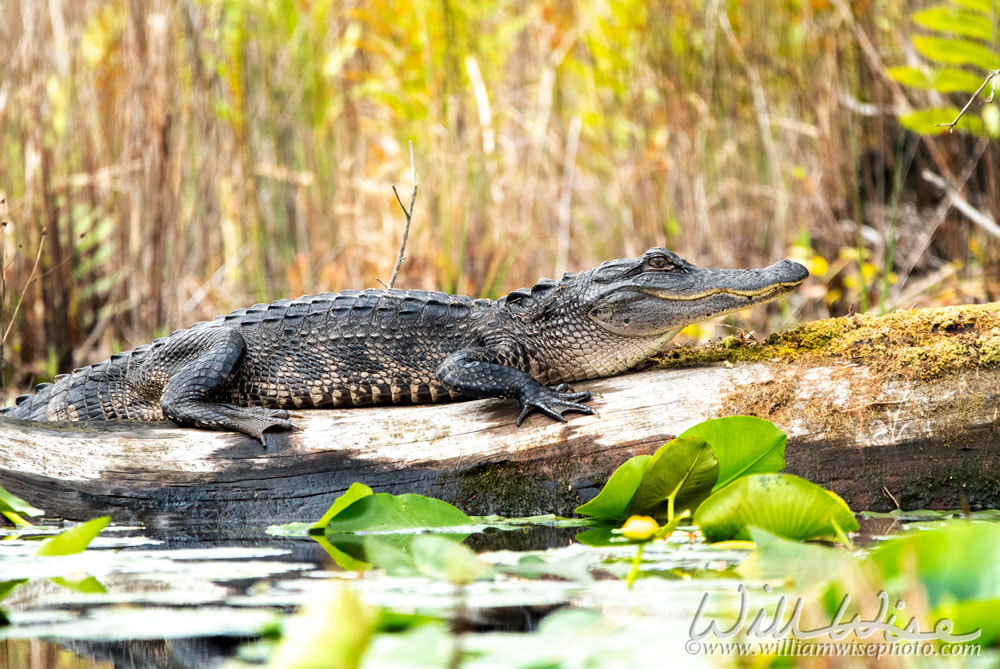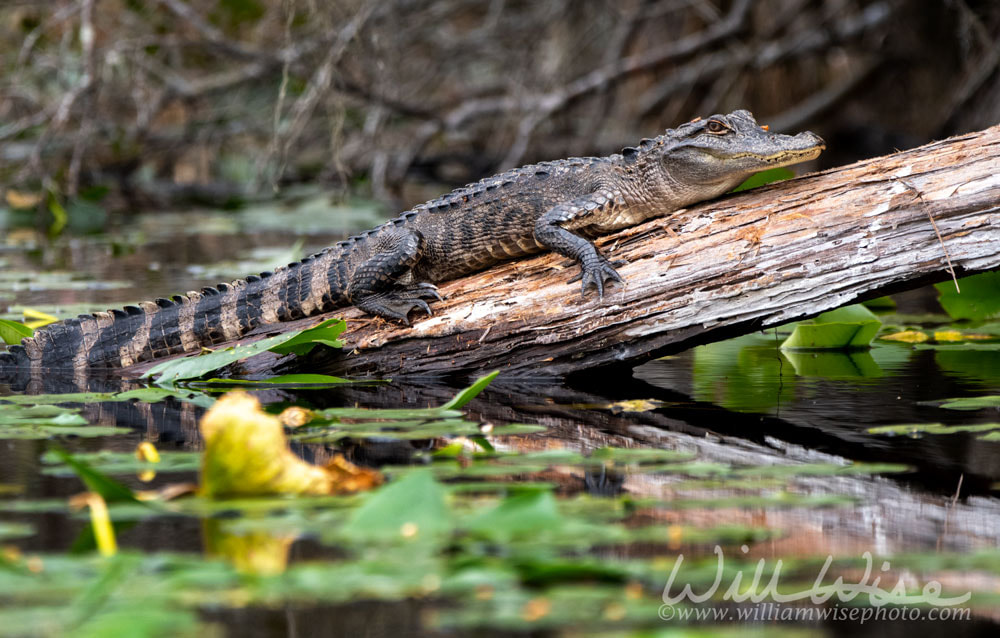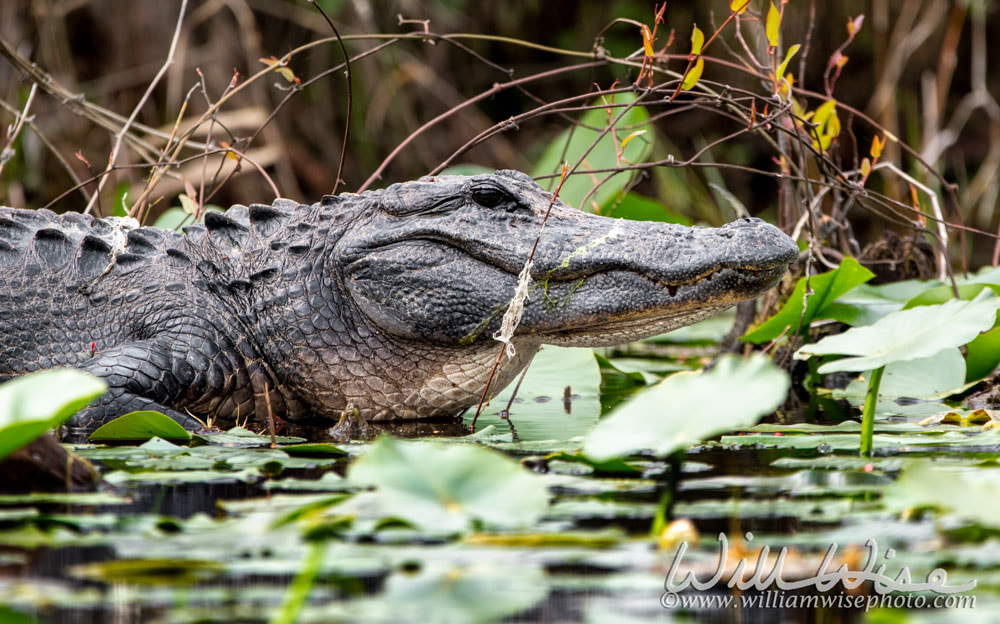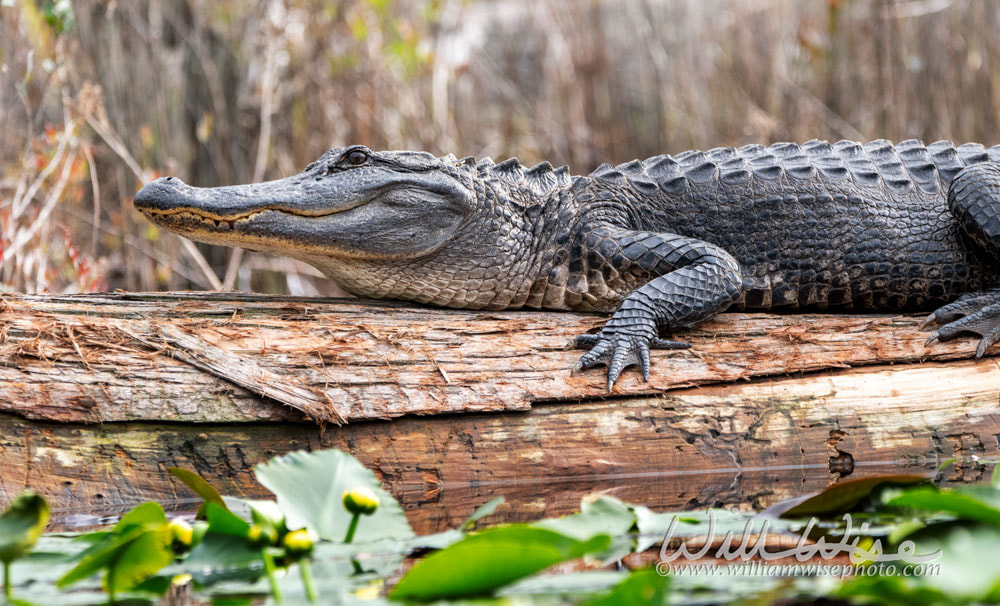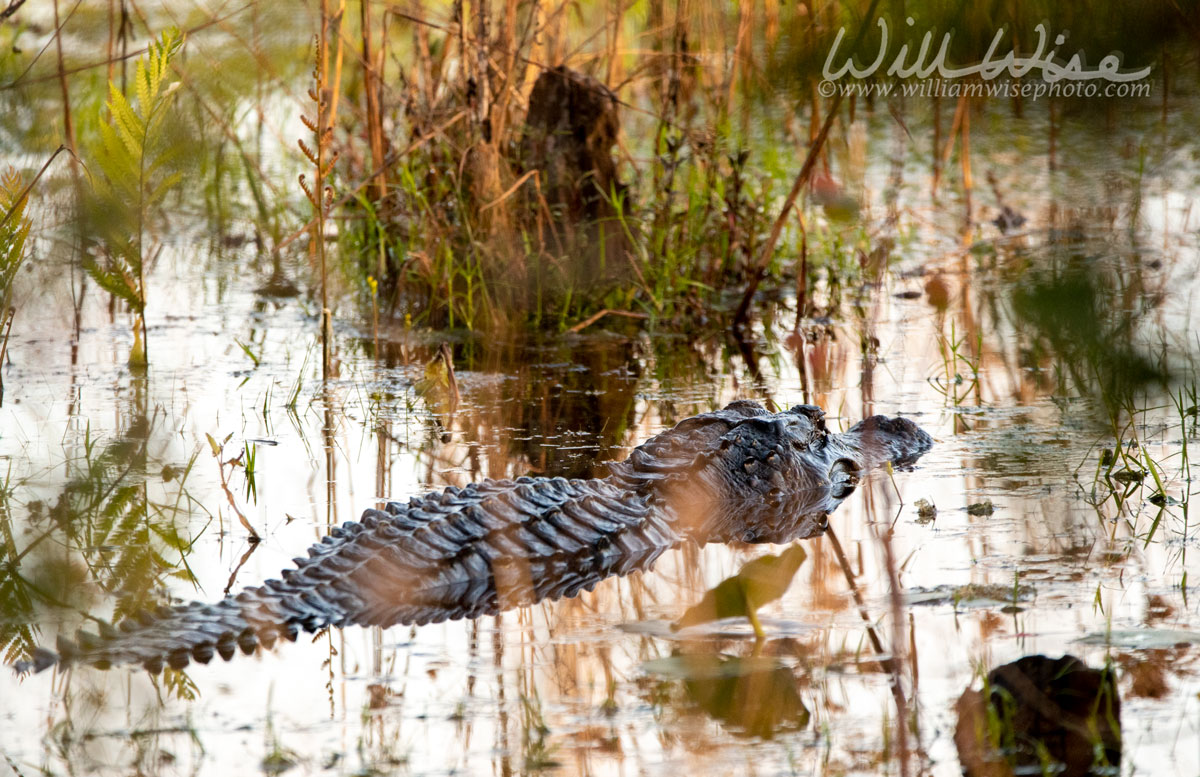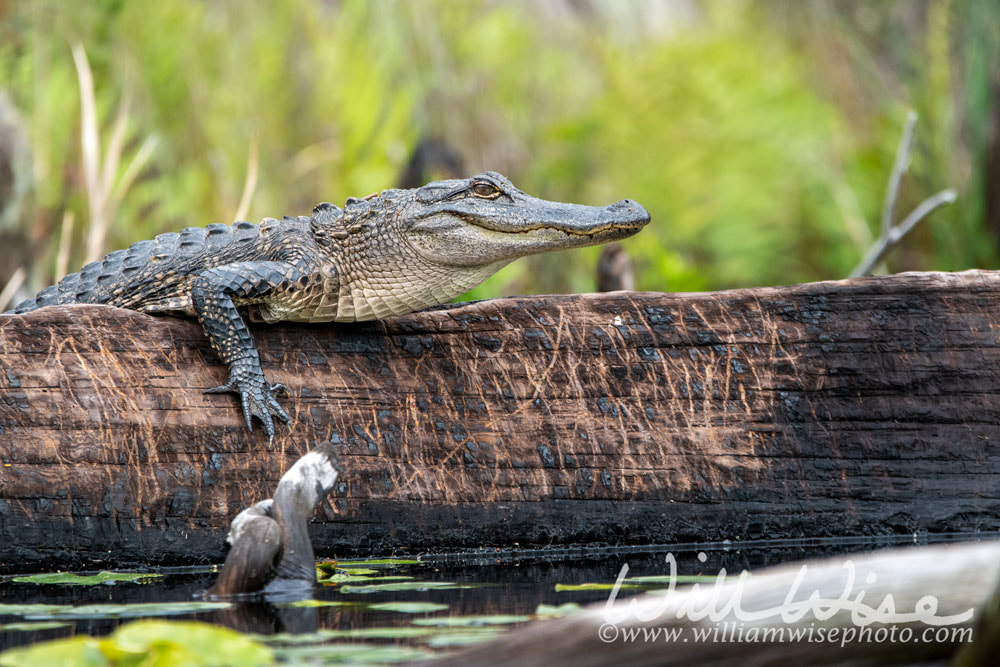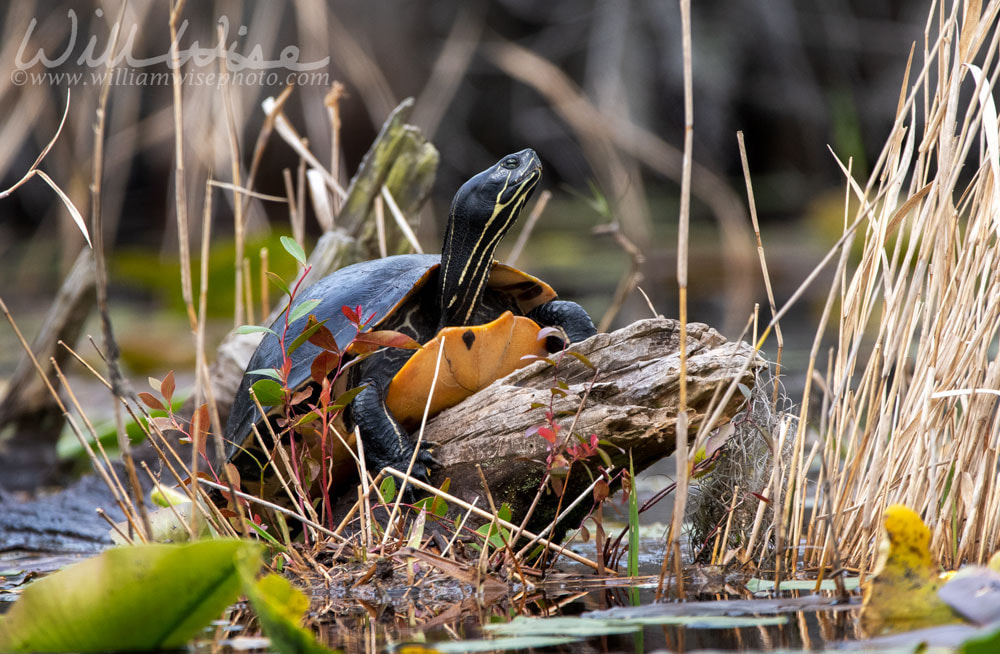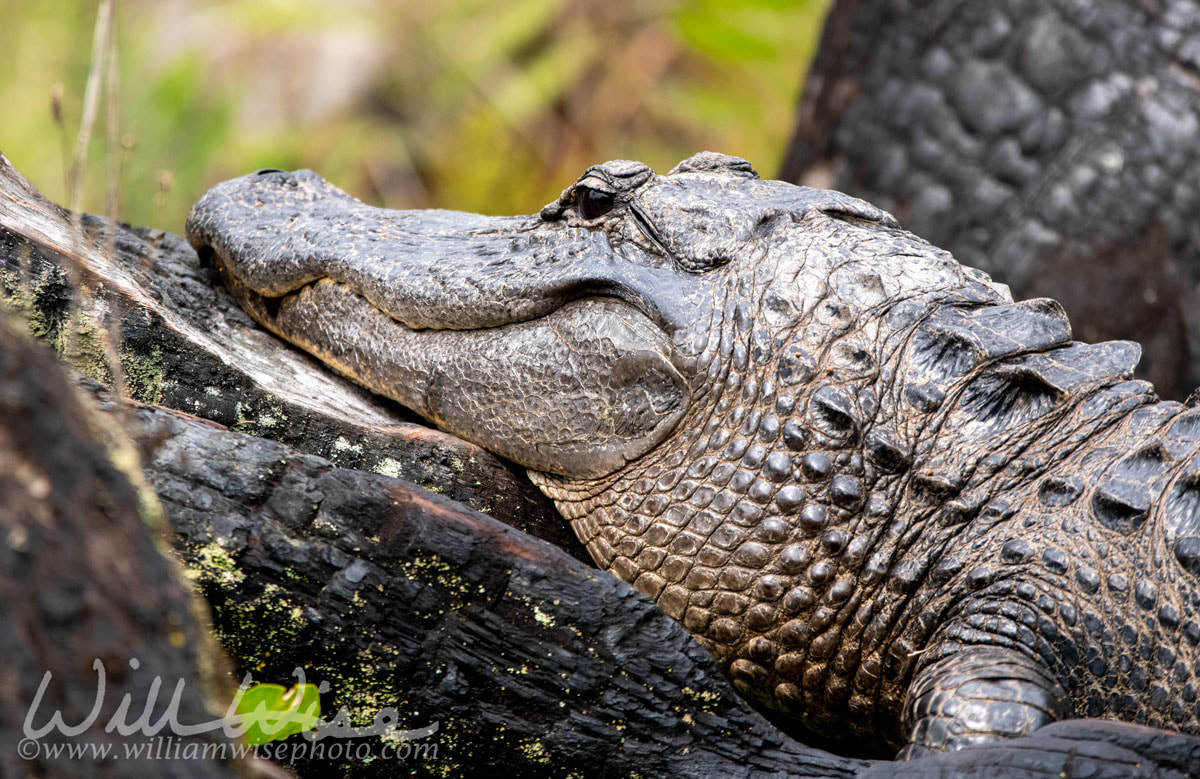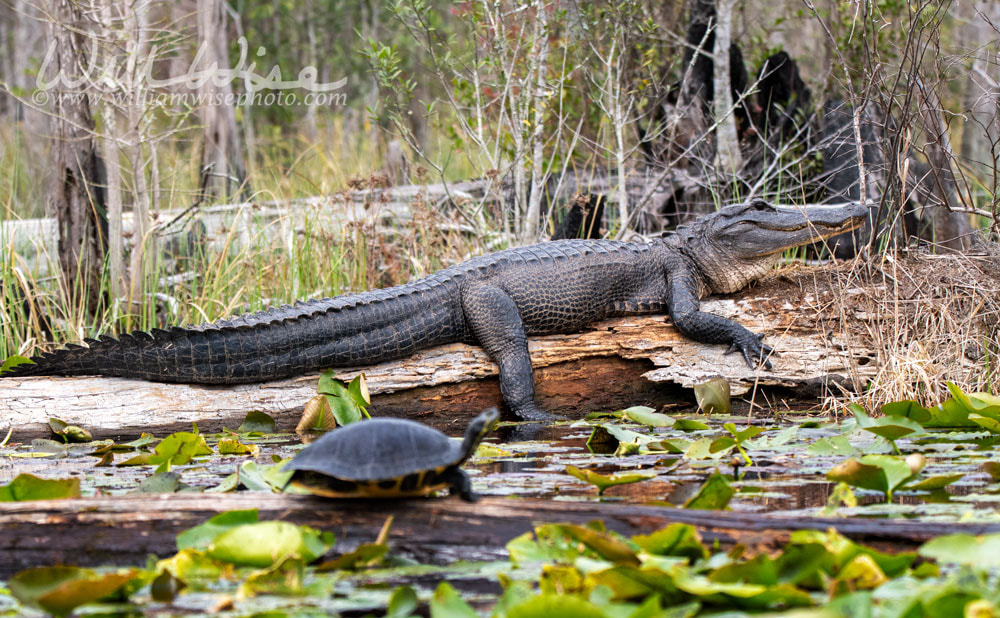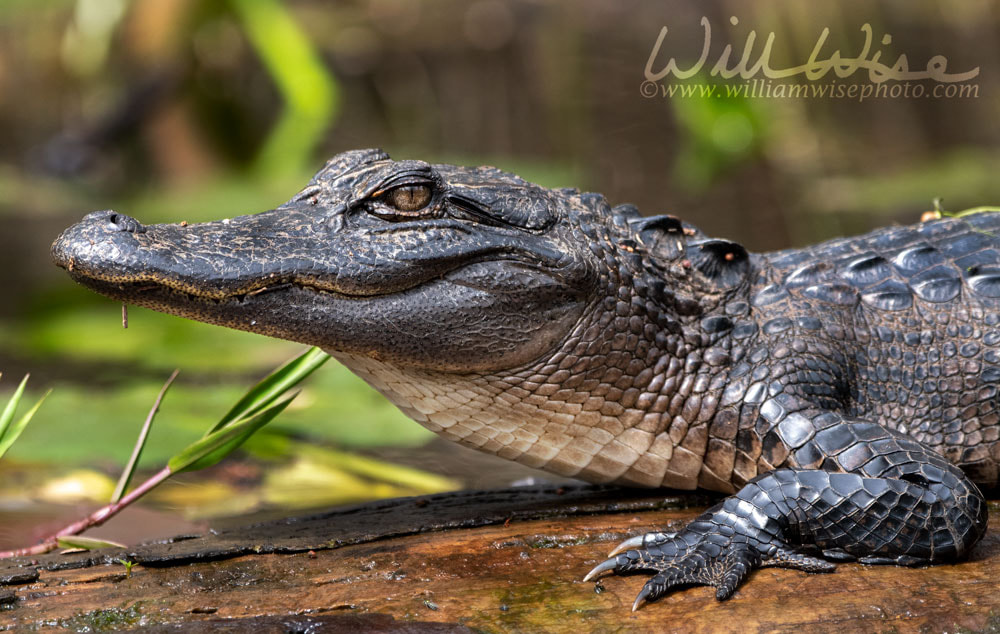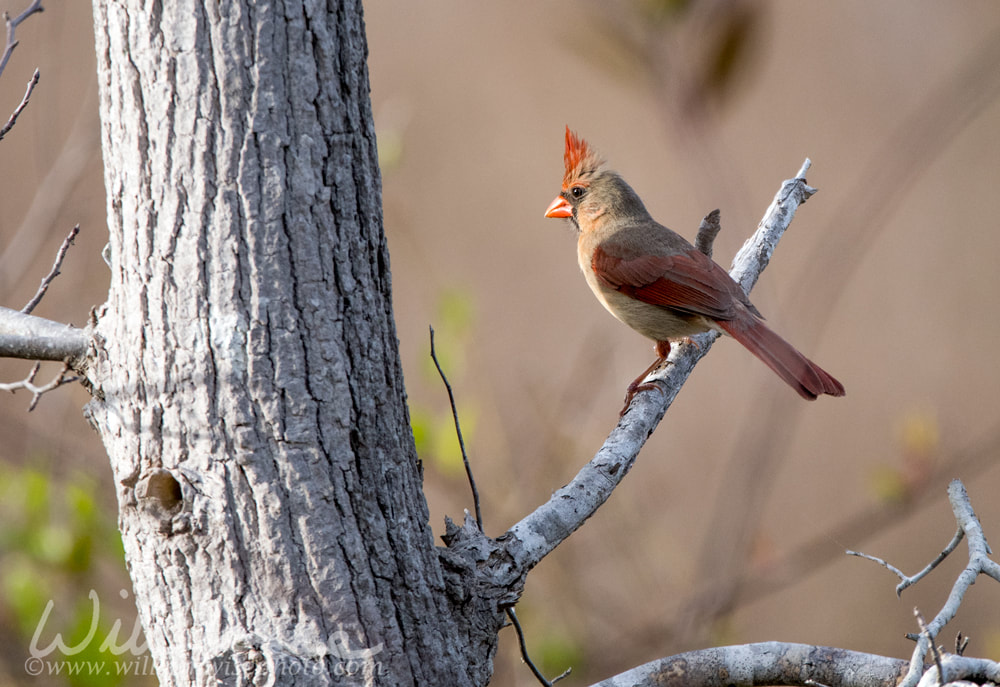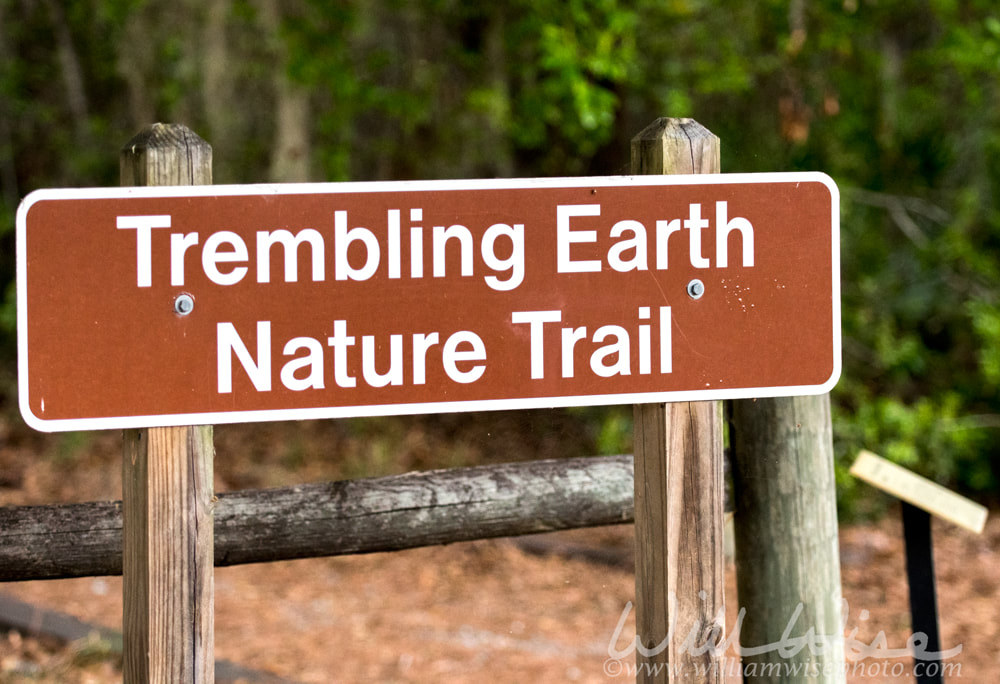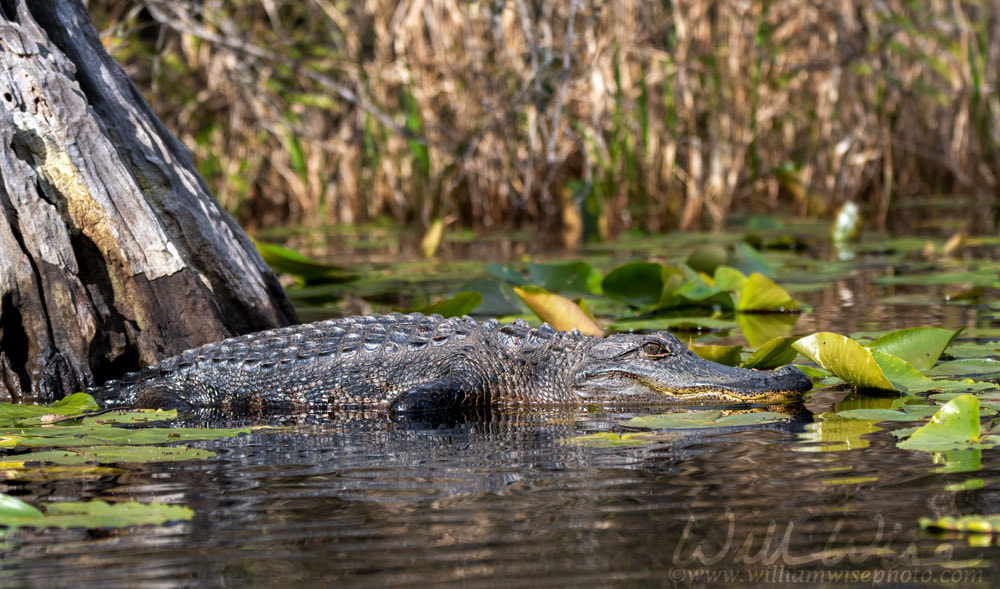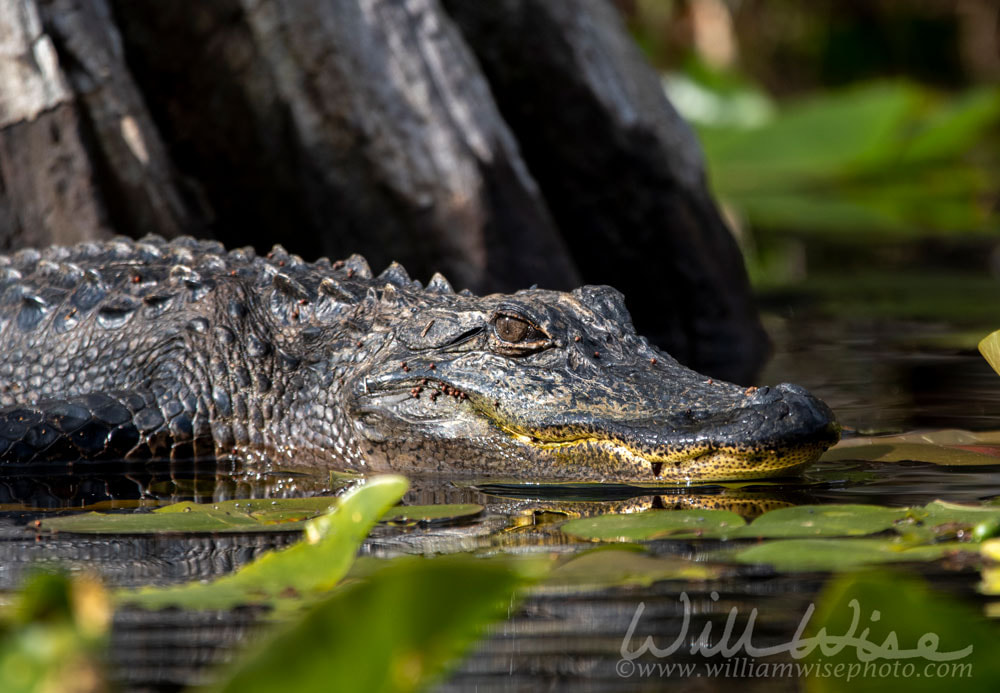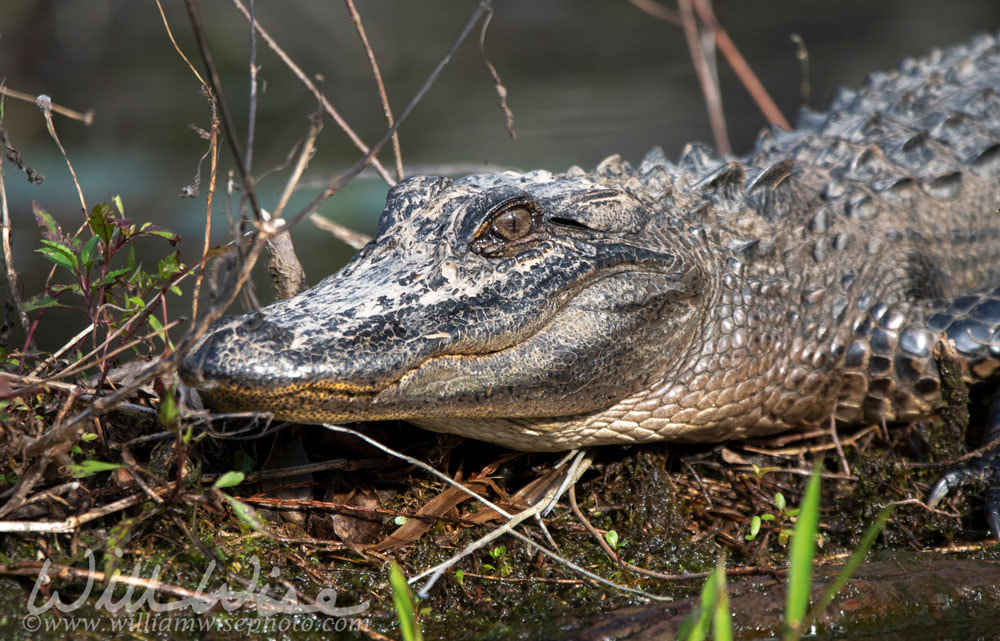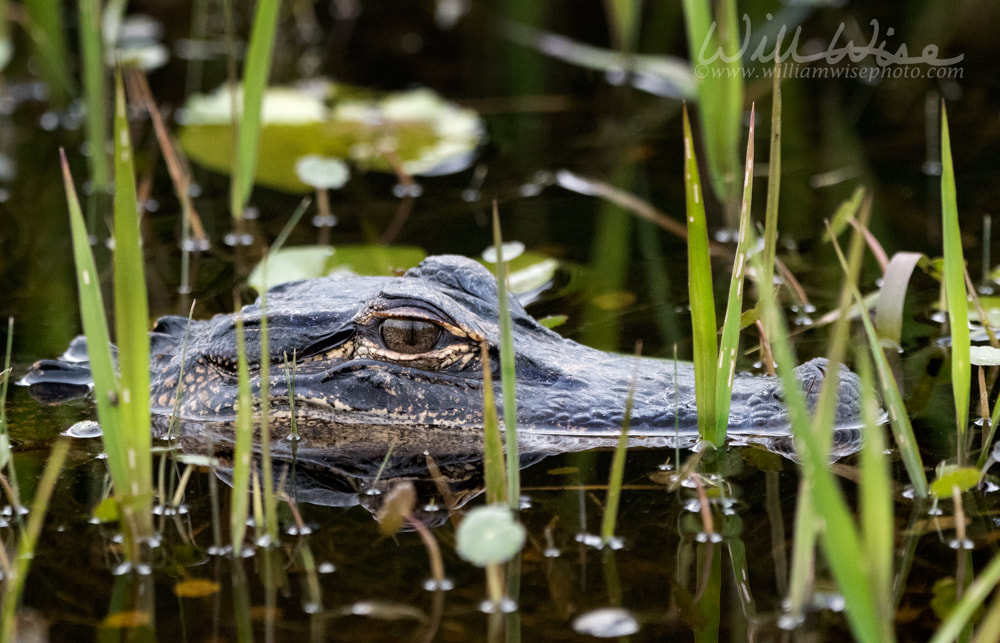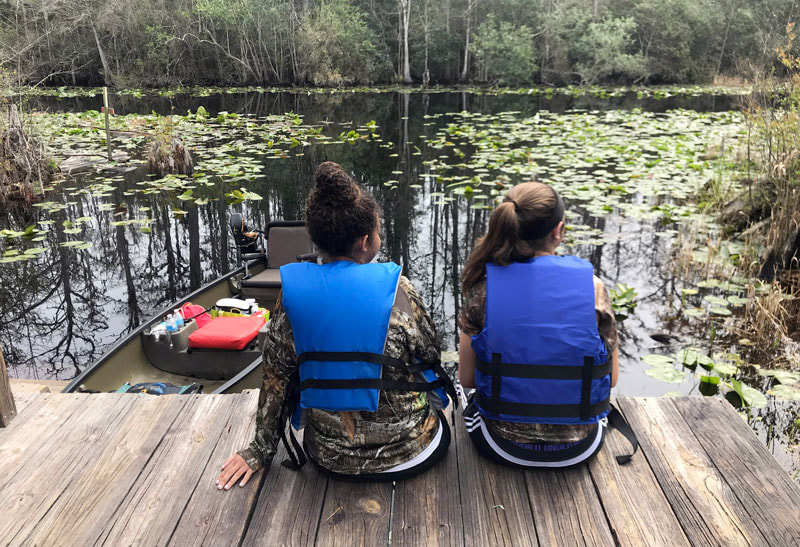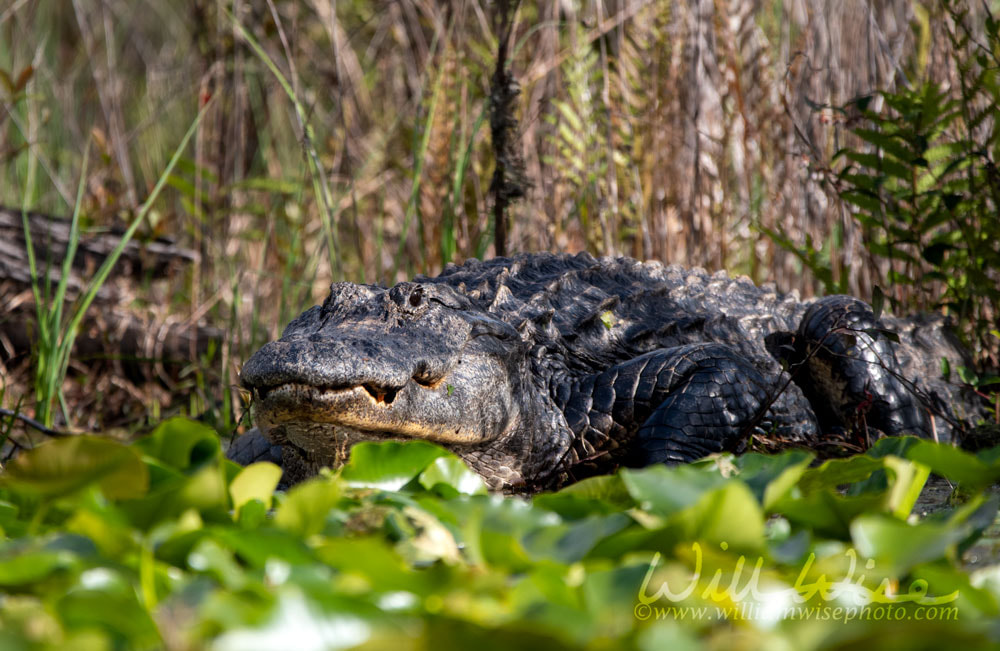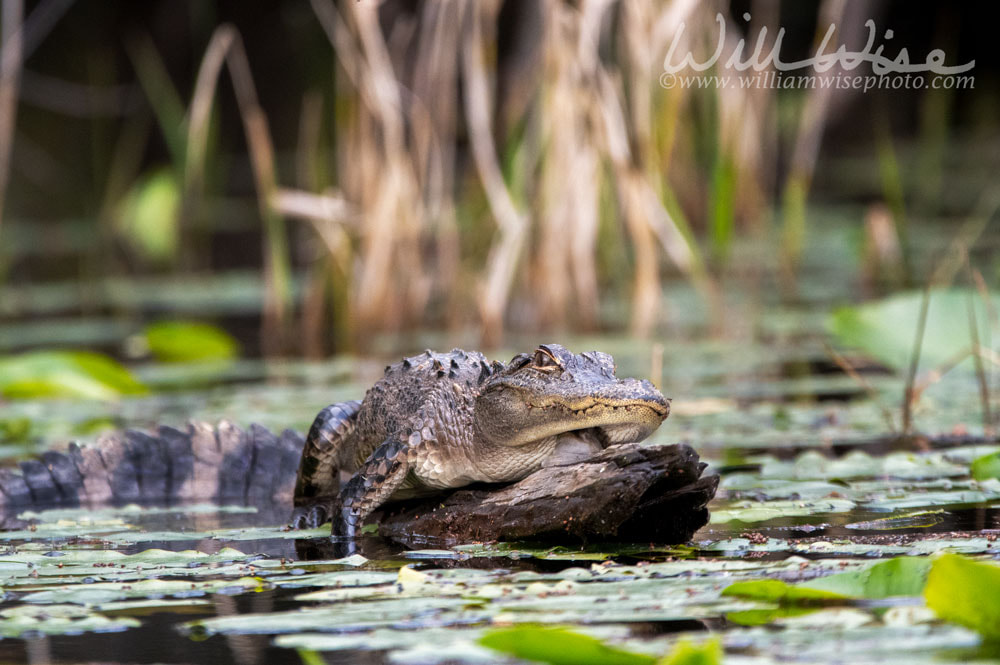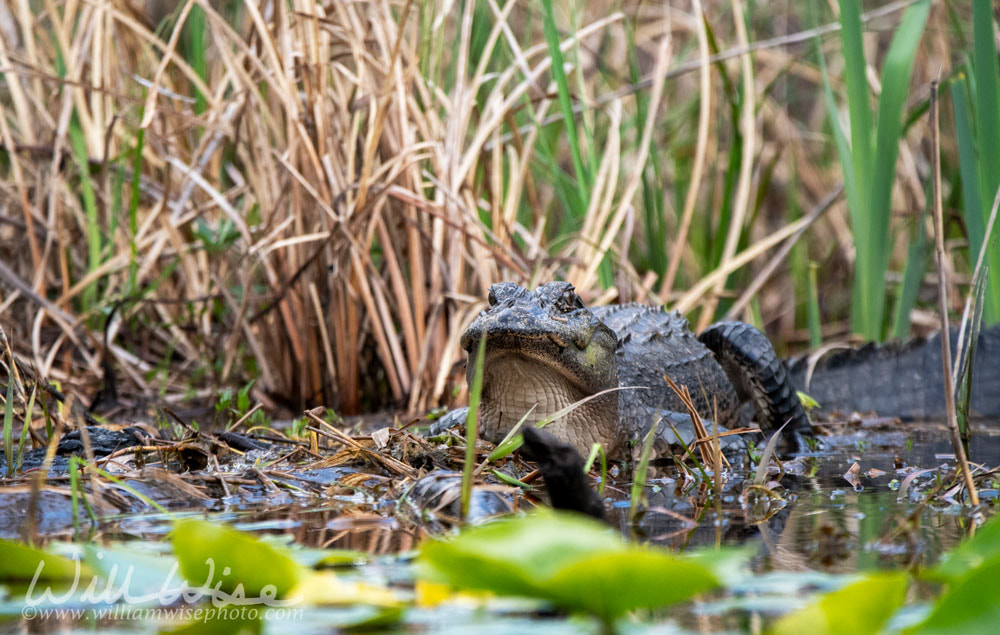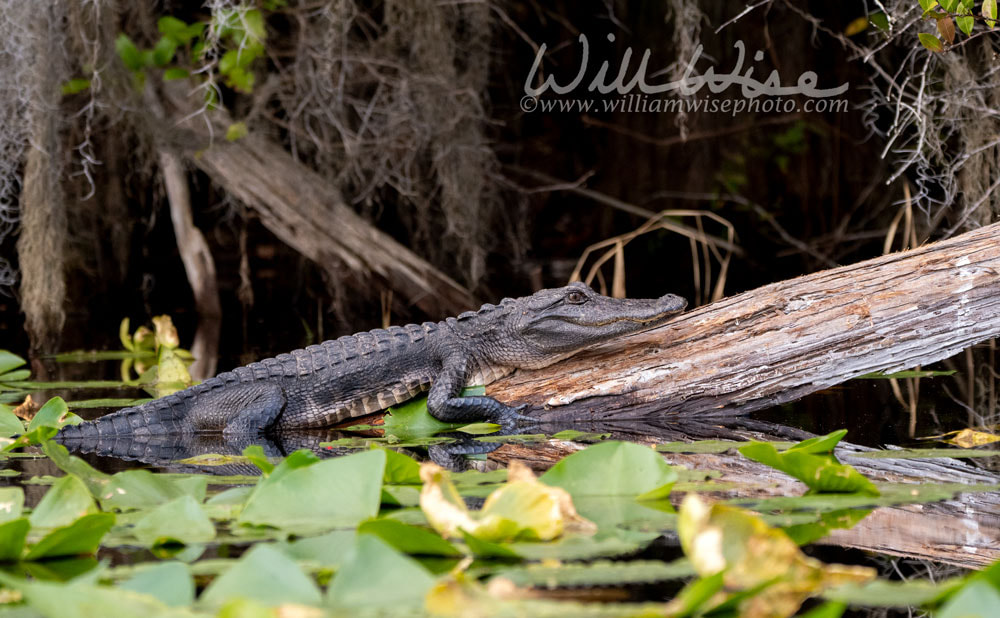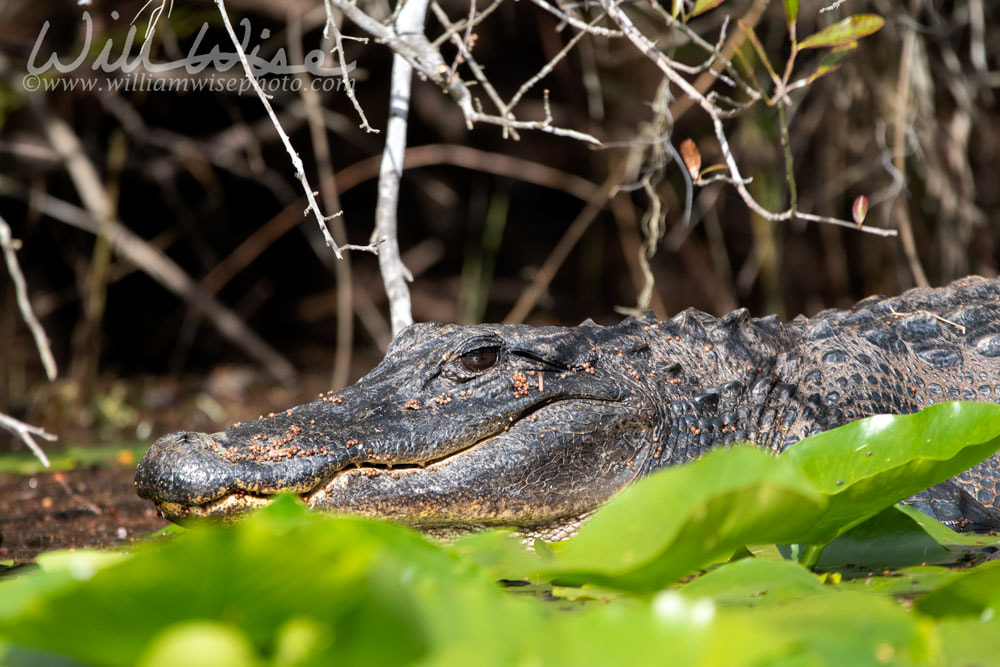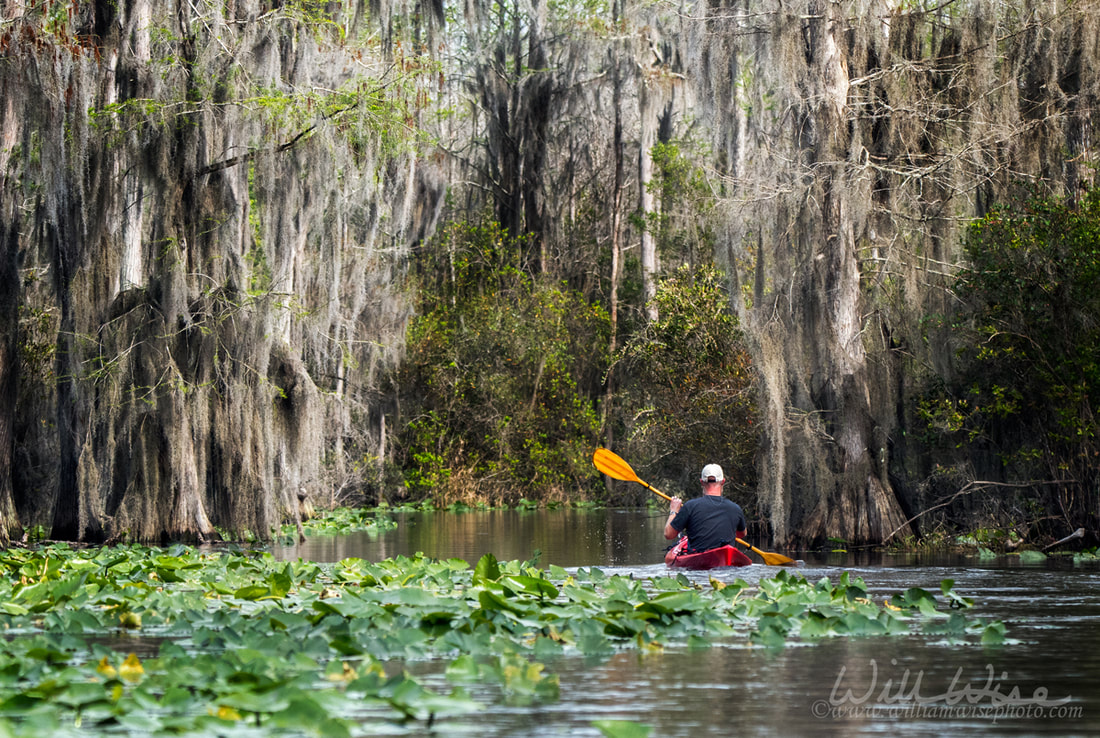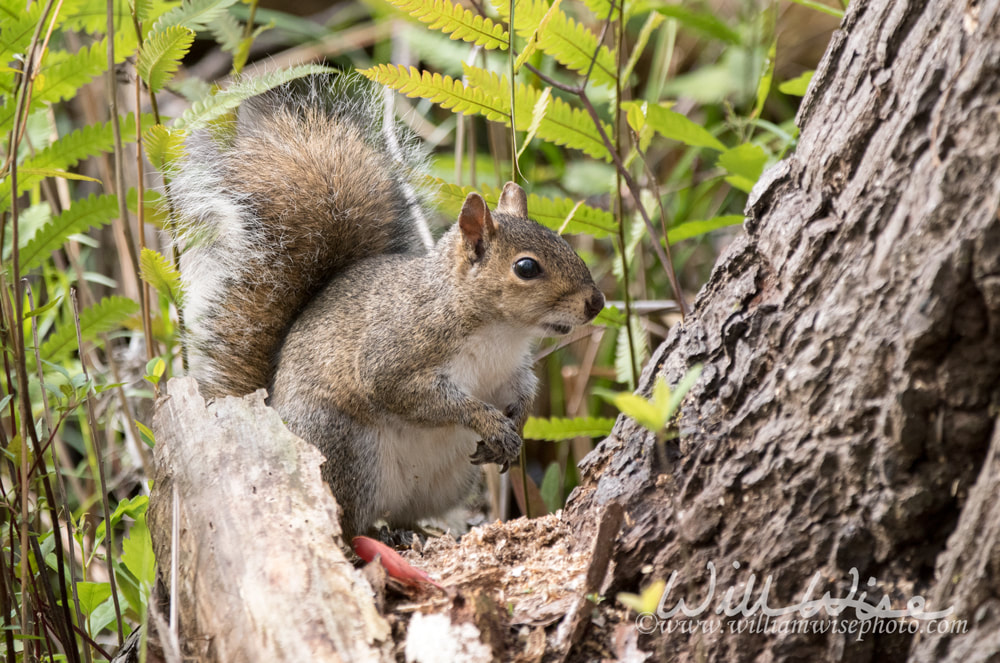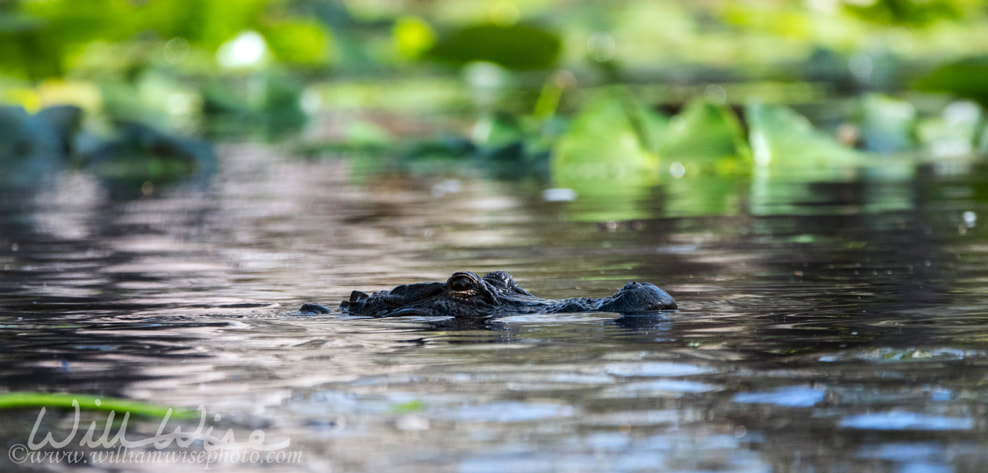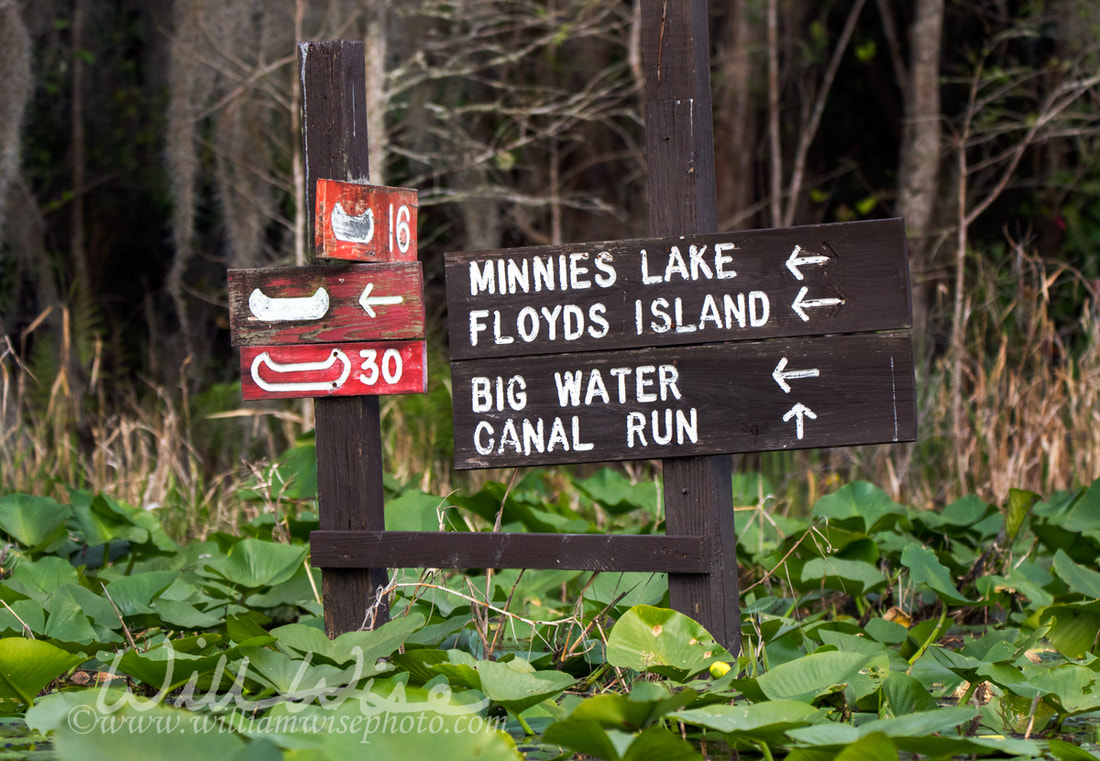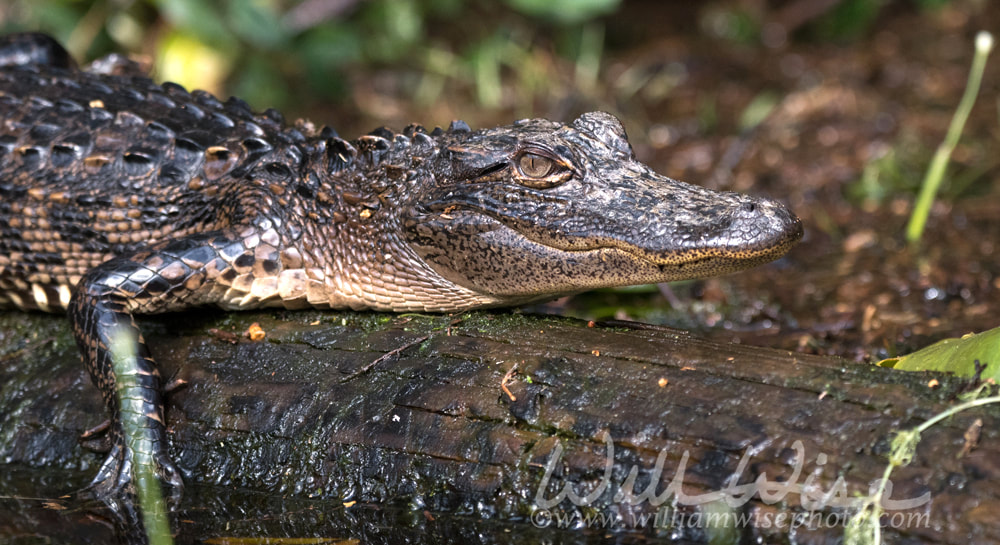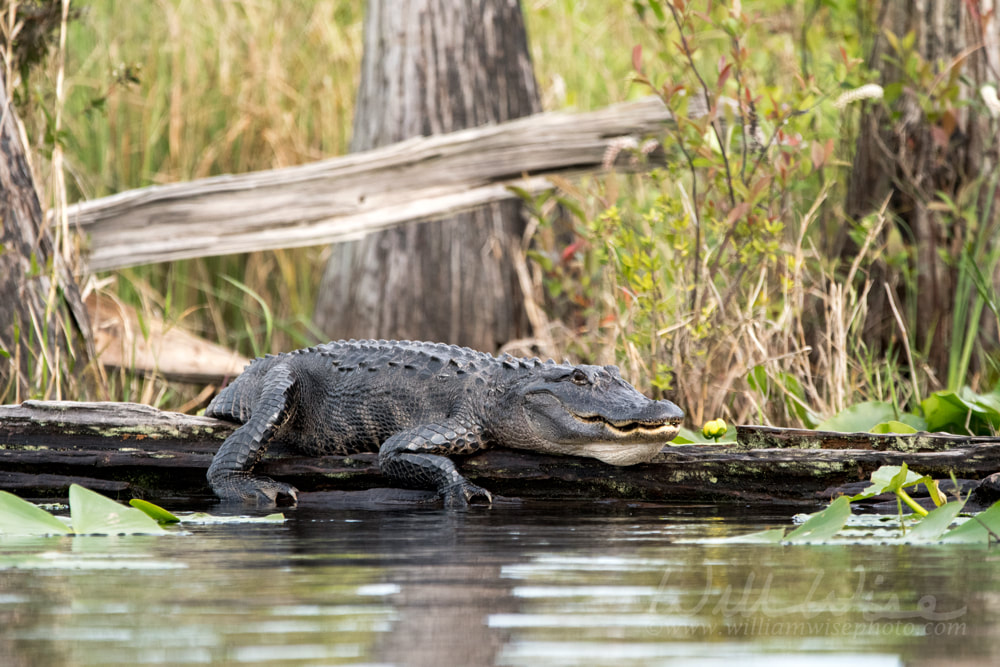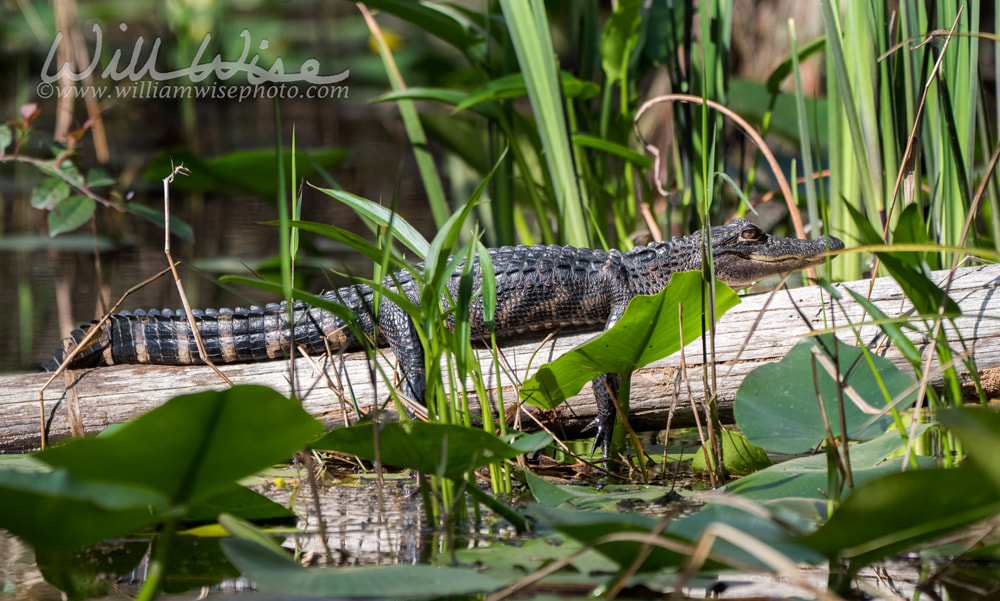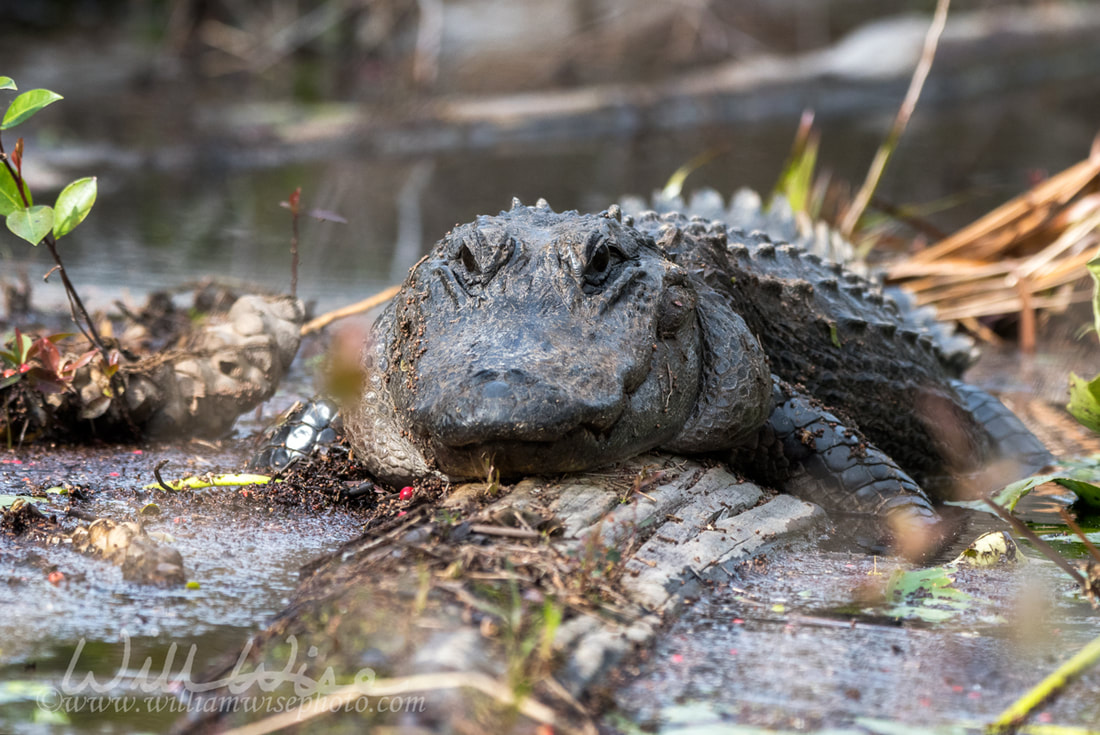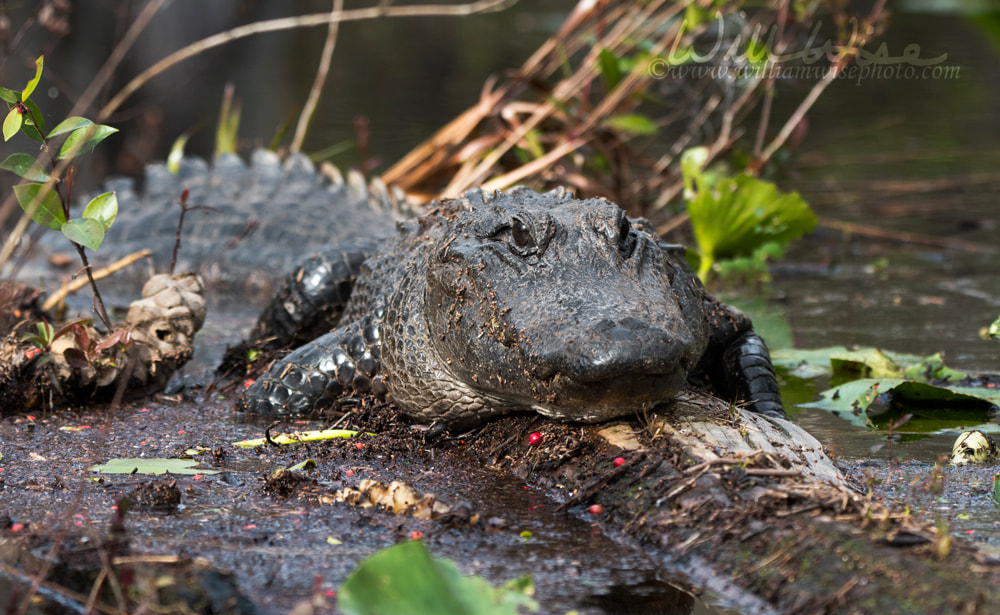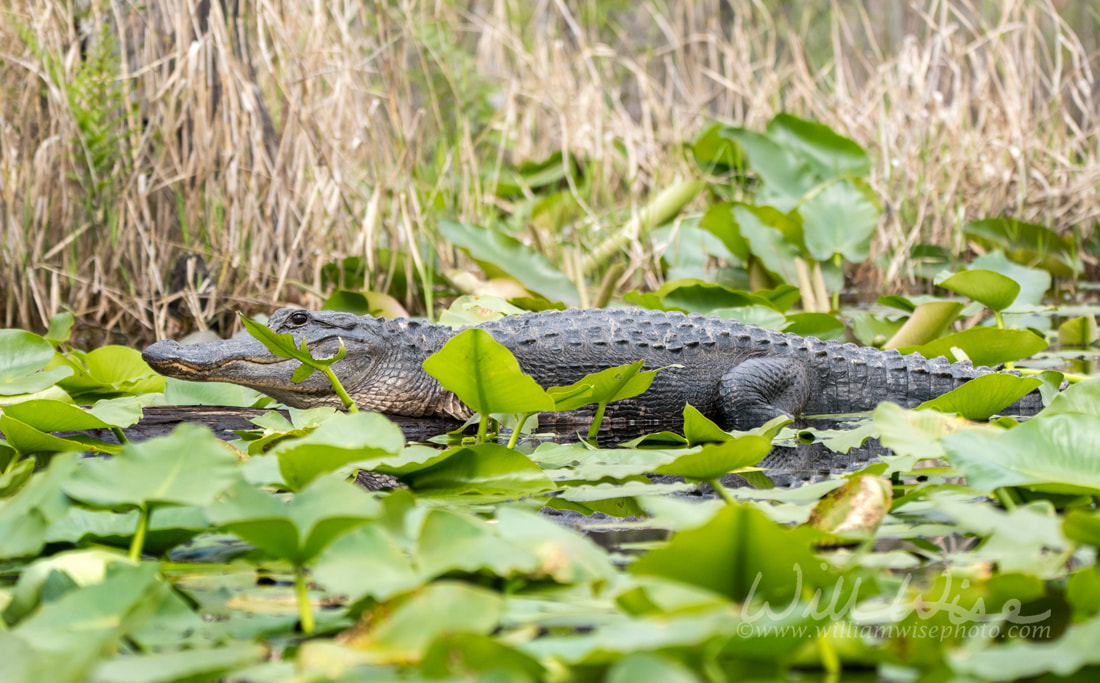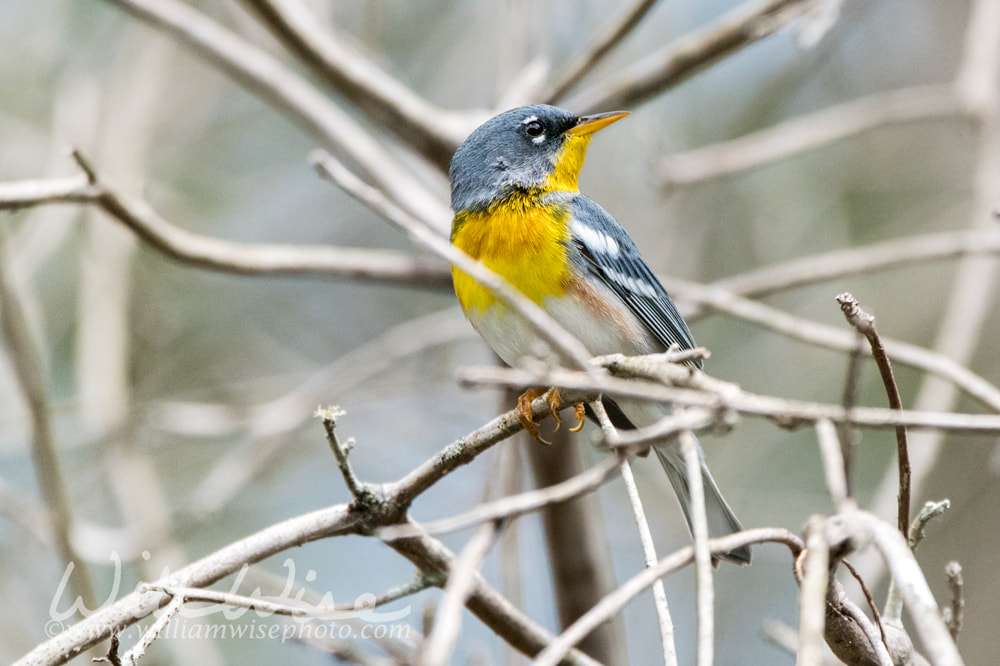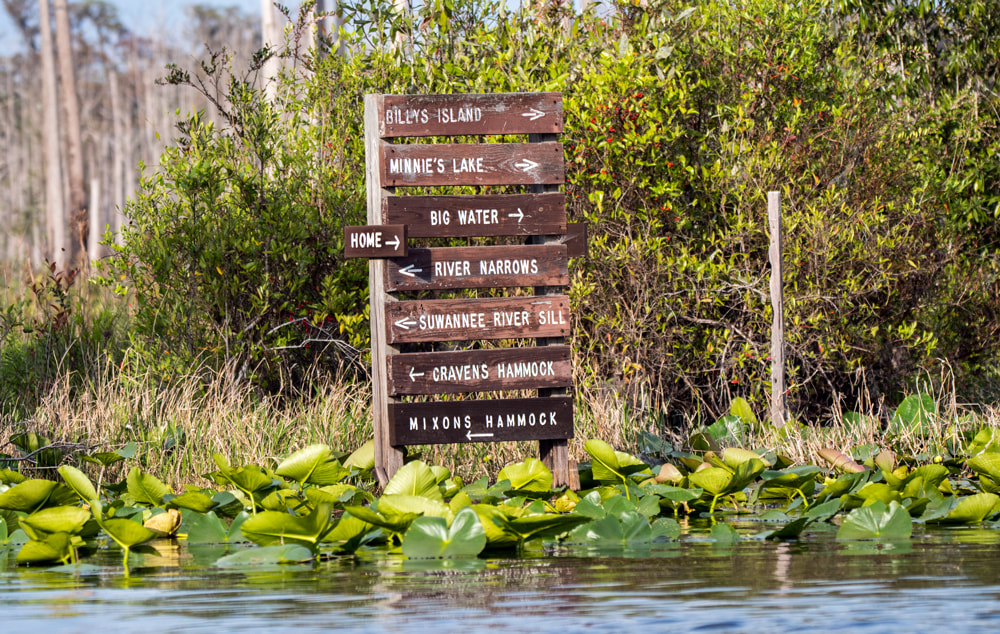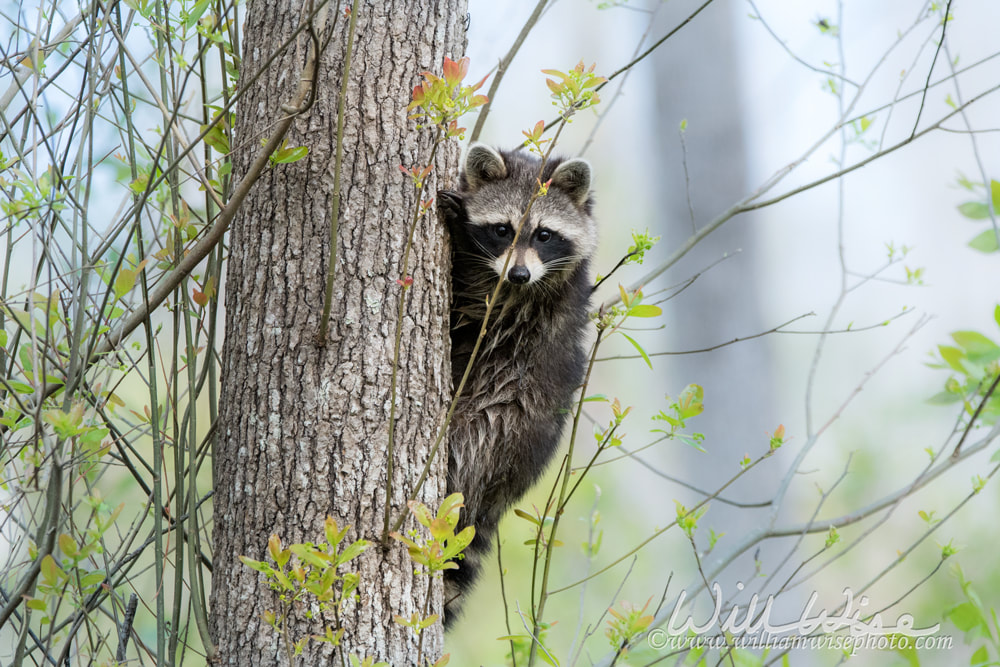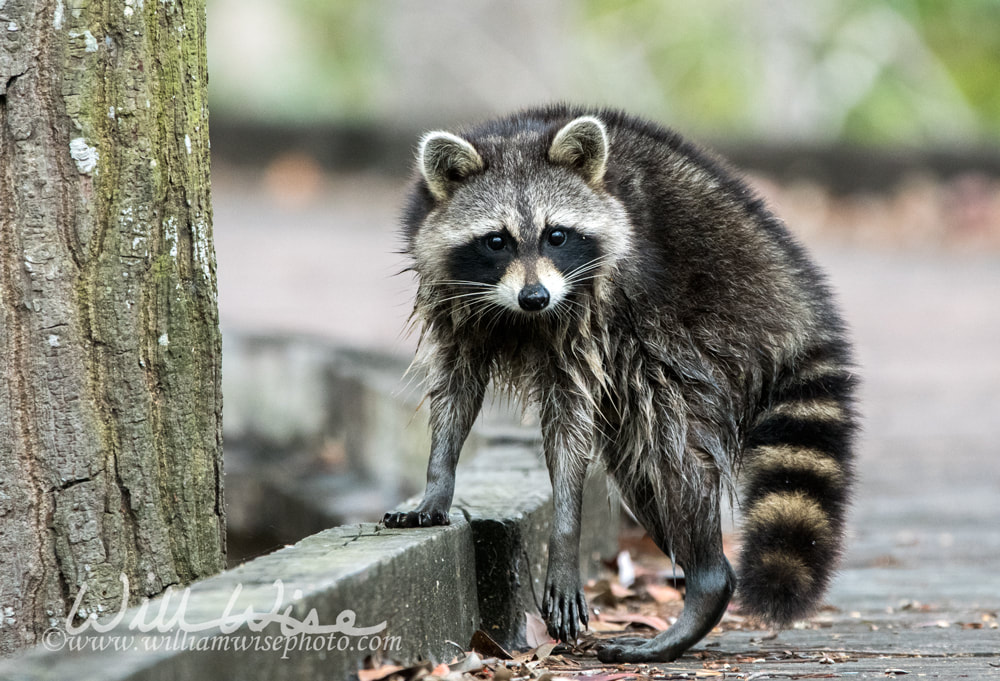 Okefenokee Photography by William Wise. A nature photo journal exploration of Georgia's Okefenokee Swamp, the Land of Trembling Earth, one of the largest blackwater swamps in North America. The alligators, birds, snakes and wildlife of Okefenokee National Wildlife Refuge and Stephen C Foster State Park. -- "What a wildly wonderful world, God! You made it all, with Wisdom at Your side, made earth overflow with your wonderful creations." Psalms 104 The Message “I have always understood,” said Bilbo the Hobbit in a frightened squeak, “that dragons were softer underneath…” The dragon Smaug stopped short in his boasting. “Your information is antiquated,” he snapped. “I am armoured above and below with iron scales and hard gems. No blade can pierce me… My armour is like tenfold shields, my teeth are swords, my claws spears, the shock of my tail a thunderbolt…!” 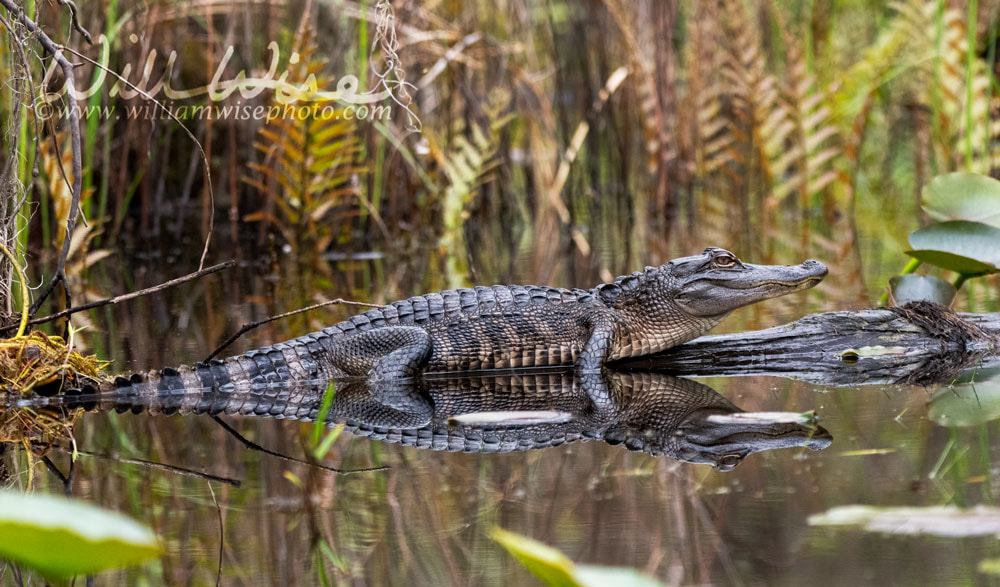 An alligator’s body is covered by a dermal exoskeleton of massive, thick, tough scales and scutes which protect it like armor. Some are touch sensitive integumentary sensory organs for sensing and locating prey in dark blackwater swamps. Okefenokee Swamp National Wildlife Refuge, Georgia. March 10, 2020. Truly, the American Alligator is a living dragon. In an entry aptly titled, Crocodilian Armor, Wikipedia states, “The epidermal exoskeleton of the alligator consists of oblong horny scales, arranged in transverse rows. The dermal exoskeleton consists of bony scutes.” Massive scutes along its back, and smaller scales along its sides, arms and hips. A close-up look reveals a mesmerizing puzzle-like pattern without gap or chink; all laid in order, above and below… an impressively armored creature! Its armor is not just as a shield during battles with his own kind, nor just for protection from the hardness of the swamp environment, but to prevent water loss and dehydration in his sultry tropical climate. Although the armor appears thick and tough, parts of an alligator’s body are quite sensitive – even more than a human fingertip. An asknature.org article says, "The touch-sensitive organs are called integumentary sensory organs. Thousands of these sensory organs cover the alligator’s face. They are especially dense around the teeth, inside the mouth, and at the tip of the snout. Researchers hypothesize that these extremely touch-sensitive areas around the mouth help the alligator locate, capture, and examine prey even when visual and sound cues are absent."
0 Comments
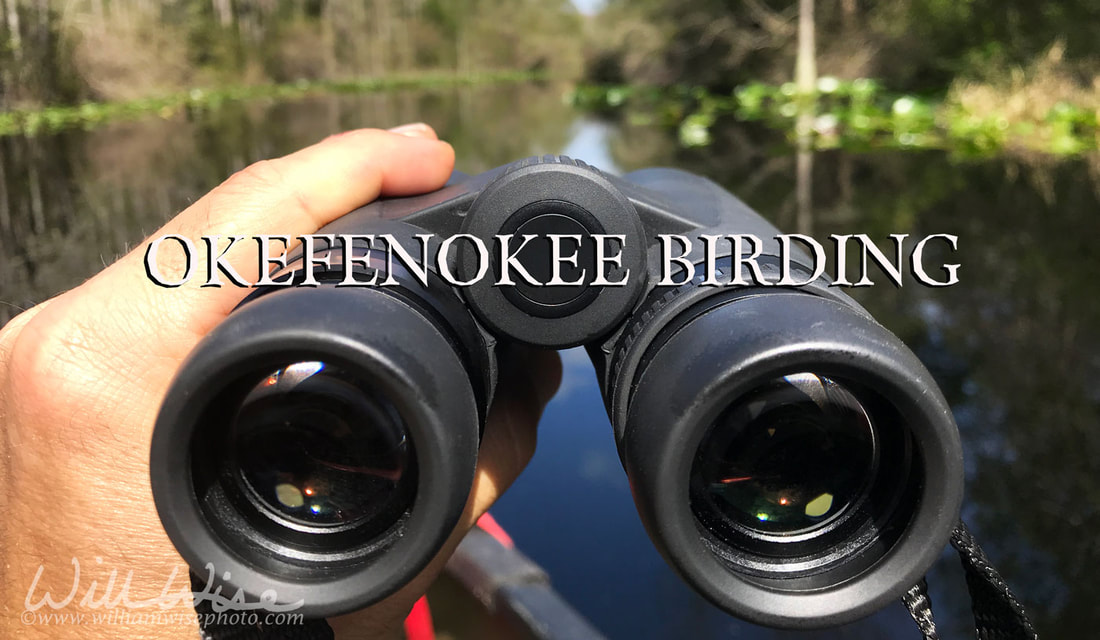 Okefenokee Photography by William Wise. A nature photo journal exploration of Georgia's Okefenokee Swamp, the Land of Trembling Earth, one of the largest blackwater swamps in North America. The alligators, birds, snakes and wildlife of Okefenokee National Wildlife Refuge and Stephen C Foster State Park. -- "What a wildly wonderful world, God! You made it all, with Wisdom at Your side, made earth overflow with your wonderful creations." Psalms 104 The Message Because it is low swamp land, there aren't any long hiking trails in the Stephen C Foster State Park in the Okefenokee. However, the park has done a great job maximizing the shorter trails. Every evening after returning off the water, and every morning waiting on my daughter to wake up, I walk the Trembling Earth Nature Trail, the Upland Trail and the Campground Trail for some birding.
 Okefenokee Photography by William Wise. A nature photo journal exploration of Georgia's Okefenokee Swamp, the Land of Trembling Earth, one of the largest blackwater swamps in North America. The alligators, birds, snakes and wildlife of Okefenokee National Wildlife Refuge and Stephen C Foster State Park. -- "What a wildly wonderful world, God! You made it all, with Wisdom at Your side, made earth overflow with your wonderful creations." Psalms 104 The Message Internet rumor has it that the alligator received its name from the Spanish explorers that claimed Florida in the 1500’s. If true, I’m sure that el legarto didn’t simply mean a lizard, but THE Lizard! For the impressive alligator is no mere squamate, but on the order of a greater magnitude: Crocodilia!
The order Crocodilia are large, predatory reptiles. They are primarily carnivorous and feast upon fish, crustaceans, birds, mammals and even other reptiles. While they are quite imposing in appearance, and some crocodilians have attacked humans (the largest number of attacks comes from the Nile crocodile), the American Alligator is rarely a threat to people. (source: https://en.wikipedia.org/wiki/Crocodilia) According to a Georgia Department of Natural Resources publication, “the opportunity for humans to experience any of the alligator’s weapons first hand will come only to those who attempt to capture one. Under natural conditions, alligators are usually shy, retiring creatures that generally mind their own business, which does not include promoting encounters with humans.” Still, el legarto is no mere lizard!  Okefenokee Photography by William Wise. A nature photo journal exploration of Georgia's Okefenokee Swamp, the Land of Trembling Earth, one of the largest blackwater swamps in North America. The alligators, birds, snakes and wildlife of Okefenokee National Wildlife Refuge and Stephen C Foster State Park. -- "What a wildly wonderful world, God! You made it all, with Wisdom at Your side, made earth overflow with your wonderful creations." Psalms 104 The Message A day paddling up the Middle Fork (red trail) of the Suwannee River in the Okefenokee Swamp, Georgia.  Okefenokee Photography by William Wise. A nature photo journal exploration of Georgia's Okefenokee Swamp, the Land of Trembling Earth, one of the largest blackwater swamps in North America. The alligators, birds, snakes and wildlife of Okefenokee National Wildlife Refuge and Stephen C Foster State Park. -- "What a wildly wonderful world, God! You made it all, with Wisdom at Your side, made earth overflow with your wonderful creations." Psalms 104 The Message “When the Swamp was first penetrated by the pioneer white settlers of this section, and that was not so very long ago, so many alligators were encountered, and they were so large and vicious, that a boatman hardly ever entered the interior without a 'pike-pole' for protection. And this was especially true if a dog was carried along, for a large alligator dearly loves dog meat, and they will run the risk of being killed by attacking a boat in order to try to pull out a hound dog.” Excerpt from History of the Okefenokee, 1926 In 1875, The Atlanta Constitution published the dramatic headline: “We now announce to our readers, and the people of Georgia, that we are fitting up an expedition for a complete and thorough exploration of Okefinokee. The full details of the plan and expedition will be published soon – if they come out alive.” Over the next months, the paper released many exciting stories from the Okefenokee Swamp.
 Okefenokee Photography by William Wise. A nature photo journal exploration of Georgia's Okefenokee Swamp, the Land of Trembling Earth, one of the largest blackwater swamps in North America. The alligators, birds, snakes and wildlife of Okefenokee National Wildlife Refuge and Stephen C Foster State Park. -- "What a wildly wonderful world, God! You made it all, with Wisdom at Your side, made earth overflow with your wonderful creations." Psalms 104 The Message As we pushed off from the Stephen C Foster State Park boat launch and into the blackwaters of the Okefenokee Swamp, I kept an eye on things. Although the giant reptiles weren’t immediately visible, there certainly could be alligators to the left and the right of our small canoe. But my cautious eye wasn’t for fear that we would be attacked or eaten, but that I might miss a great photo opportunity! Not many strokes into our paddling trip, as I scanned the Spatterdock lily pads, I espied a cautious eye staring back at us and keeping a close look upon our actions! A large alligator lay mostly submerged just a few feet off to my left. Her eye remained fixed upon us as we drifted by, ready to submerge if we encroached into her comfort zone. Billy’s Lake, just up from the Stephen C Foster campground, is always full of large alligators. At times they are laying on logs and floating peat beds every few feet. Other times, depending upon the weather, they lie mostly submerged. But keep a keen eye and you’ll begin spotting them all through this beautiful blackwater lake within the majestic Okefenokee Swamp! A great start to our 2020 Okefenokee paddling trek! iNaturalist Observation: https://www.inaturalist.org/observations/39962898  Okefenokee Photography by William Wise. A nature photo journal exploration of Georgia's Okefenokee Swamp, the Land of Trembling Earth, one of the largest blackwater swamps in North America. The alligators, birds, snakes and wildlife of Okefenokee National Wildlife Refuge and Stephen C Foster State Park. -- "What a wildly wonderful world, God! You made it all, with Wisdom at Your side, made earth overflow with your wonderful creations." Psalms 104 The Message Teenagers. Waiting for my daugher and friend to wake up, I had extra time to stroll the Trembling Earth Nature Trail in the Stephen C Foster State Park campground. On one stroll, I took my focus off the alligators and avians, and tried to hit a few of the plants.
 Okefenokee Photography by William Wise. A nature photo journal exploration of Georgia's Okefenokee Swamp, the Land of Trembling Earth, one of the largest blackwater swamps in North America. The alligators, birds, snakes and wildlife of Okefenokee National Wildlife Refuge and Stephen C Foster State Park. -- "What a wildly wonderful world, God! You made it all, with Wisdom at Your side, made earth overflow with your wonderful creations." Psalms 104 The Message Chilly Water and Warm Air...“Wow, that water’s cold!” I exclaimed as I put my hand over the side of our canoe and dipped my fingers into the dark, tannin-stained waters of the Okefenokee Swamp. But the sun overhead was pleasantly warm. It was late in the afternoon, and as we circled Billy’s Lake, all the big gators were out in the sun. Even as we pulled our canoe in close, they were reluctant to dive back into the cold water. That is why I love to come in March. Climbing temperatures on top of still cool waters means the alligators pull their full glory on every sunning spot for great photography! Taylor Schoettle in A Naturalist’s Guide to the Okefenokee Swamp, writes, “Springs are delightfully long and may extend from middle February through May with temperatures in the 60s and low 80s with steady daily breezes.” Springtime is the perfect time to Okefeonkee!  Okefenokee Photography by William Wise. A nature photo journal exploration of Georgia's Okefenokee Swamp, the Land of Trembling Earth, one of the largest blackwater swamps in North America. The alligators, birds, snakes and wildlife of Okefenokee National Wildlife Refuge and Stephen C Foster State Park. -- "What a wildly wonderful world, God! You made it all, with Wisdom at Your side, made earth overflow with your wonderful creations." Psalms 104 The Message Last minute packing, under-inflated trailer tires, construction on the interstate, slow drivers… just all the typical things that take place in this hectic world. We arrived in the Okefenokee later than I had desired. But once upon the waters of the swamp, all that was left behind. No cellular signal, no traffic noise, no way to even log on and work from home! This year's trip was special. My daughter brought along a friend this time... her first trip to the swamp; her first time being face-to-face with an alligator. We pushed off from the Stephen C Foster State Park boat dock for an hour paddle around Billy’s Lake. Thankfully, the gators did not disappoint. Being around 75 degrees, there were many large alligators out of the cold water and laid out on the logs and mound to soak up the last solar rays warming their reptilian bodies. We got a couple of medium-sized gators to make a splash and spectacle for Gabrielle as they dove to the water to avoid our close approach. But she said it was more eerie when they slowly slunk off their stumps, crawled toward us into the blackwaters, and disappeared under the lily pads. She feared they were coming under our canoe to dump us in!
 Okefenokee Photography by William Wise. A nature photo journal exploration of Georgia's Okefenokee Swamp, the Land of Trembling Earth, one of the largest blackwater swamps in North America. The alligators, birds, snakes and wildlife of Okefenokee National Wildlife Refuge and Stephen C Foster State Park. -- "What a wildly wonderful world, God! You made it all, with Wisdom at Your side, made earth overflow with your wonderful creations." Psalms 104 The Message By the time we made our six-hour drive, set up camp and unpacked, it was 4:30 when we hit the waters of Billy's Lake in the Okefenokee Swamp. Technically, we had only thirty minutes until we were supposed to be off the water, but we paddled around the edges for an hour. The spatterdock, logs and peat islands were still covered by gators taking in the last of the evening sun.  Okefenokee Photography by William Wise. A nature photo journal exploration of Georgia's Okefenokee Swamp, the Land of Trembling Earth, one of the largest blackwater swamps in North America. The alligators, birds, snakes and wildlife of Okefenokee National Wildlife Refuge and Stephen C Foster State Park. -- "What a wildly wonderful world, God! You made it all, with Wisdom at Your side, made earth overflow with your wonderful creations." Psalms 104 The Message Tomorrow morning my daughter and I embark on our annual Okefenokee Swamp paddling trip! And this time, she is bringing a friend who has never visited the swamp before. I love sharing this unique world of the Okefenokee with others. I’m sure she’ll be absolutely amazed.
We will be staying at our regular spot: site #4 in the Stephen C Foster State Park campground. Our food is all packed, the canoe is loaded, all is prepared and after a four hour drive, we’ll be in one of my favorite natural places! Once that canoe hits the water, which way will we go? Which of our favorite gator watering holes will we visit… Big Water… Minnie’s Lake? Where will we get out and explore… Floyd’s Island… Billy’s Island? Is it up the Red Trail, or squeeze through The Narrows? Whichever we choose, it will be an incredible time as usual. I love the swamp! 
Okefenokee Photography by William Wise. A nature photo journal exploration of Georgia's Okefenokee Swamp, the Land of Trembling Earth, one of the largest blackwater swamps in North America. The alligators, birds, snakes and wildlife of Okefenokee National Wildlife Refuge and Stephen C Foster State Park. -- "What a wildly wonderful world, God! You made it all, with Wisdom at Your side, made earth overflow with your wonderful creations." Psalms 104 The Message
Adventurers to the Okefenokee National Wildlife Refuge in the southeastern United States can apply for permits to overnight at several locations such as Mixon's Hammock, Floyd's Island, and Canal Run. But even if opting to return to a base camp at the Stephen C Foster State Park campground each evening, there are still plenty of canoe trails to fill each day with adventure. There are several options once you hit the water:
Part 3: Where to Paddle
Billy’s Lake
If you are just looking for a morning or afternoon of cruising the open waters for birding and spotting gators, you can spend several hours and never need get more than 4 miles from “home”. As soon as you paddle up the channel from Stephen C Foster State Park’s boat launch you come upon Billy’s Lake. This is one of the largest lakes in the Okefenokee and is about 3.5 miles long. The lake is lined with lily pads, floating beds of peat and hummocks, and burned or fallen logs often topped with basking alligators of all ages and lengths. The shores of Billy’s Lake are also lined with the towering and grand Bald Cypress tree (Taxodium distichum) decorated with Spanish Moss swaying in the breeze. As comorants and herons perch overhead or dive below, there is no end to the photographic opportunities.
If you go out in the morning, turn right out of the Stephen C Foster channel and paddle hard and fast to the east. After a few miles, turn your canoe around and slowly cruise westward along the lake’s shore with the sun over your shoulder. If going out in the evening, do the exact opposite. Facing the wrong direction produces a blinding glare; facing the correct direction with the sun over your shoulder is golden photography!
Explore Billy’s Lake at sunrise and sunset, but when the harsh mid-day light is overhead, head up the shadowed narrow trails of the Okefenokee…
The Red Trail
Getting off Billy’s Lake and up the middle fork of the Suwannee River (the red trail) gives you a real taste of “swamp”. Here the canoe trail narrows, the Spanish Moss laden Cypress Trees block the sky overhead and the brush closes in on the sides. Your trek twists and turns about the textured cypress knees and other organic debris along the path. Red-shouldered Hawks scream unseen overhead and Wood Ducks squeal as they take off at your approach. If you’re lucky, you’ll spot a pod of baby alligators in one of these more secluded spots!
Even with a trolling motor going most of the day, we never reached the northern end of the day-use trail! There is plenty of waterway to fill the day without applying for an overnight permit. As you travel northward, the trail opens up to other lakes and prairies. Minnie’s Lake always hosts a large gathering of gargantuan gators.
We paddle the first several hours of the day northward to Big Water lake. There we each lunch, photograph the gators and Little Blue Herons, and then head back south for “home” at Stephen C Foster State Park.
Eastward to Billy’s Island
Typically on our first or last day, when we only have a few hours, we travel east on Billy’s Lake to Billy’s Island. There is a boat dock there and you can get out and explore. We haven’t ventured far on the island, but friends have found Easton Diamondbacks, baby gators and other things. It is a good place to get out of the canoe, stretch your legs and do a little birding.
Westward toward “The Sill”
On one of our trips we paddled west from Billy’s Lake and into the River Narrows. As the name implies, this was some tricky canoe navigation! But passing through the narrows, we came out onto a beautiful prairie. You can see evidences of the old logging days, including burned out stumps and the posts of an abandoned railroad track. Paddling “The Sill” wasn’t as attractive as other areas of the swamp. Being a man-made canal, it is wide, flat and straight without much scenery surrounding it. However, further up the canal we did find some of the biggest alligators we have seen on our trips. Unless we have several days to explore, I don’t plan another trip up The Sill. If your time is limited, paddling up the red trail to Minnie’s Lake and Big Water are the way to go! Again, I’m no Okefenokee expert, so I’d love to hear what others have to say; especially those of you who have overnighted in the swamp! 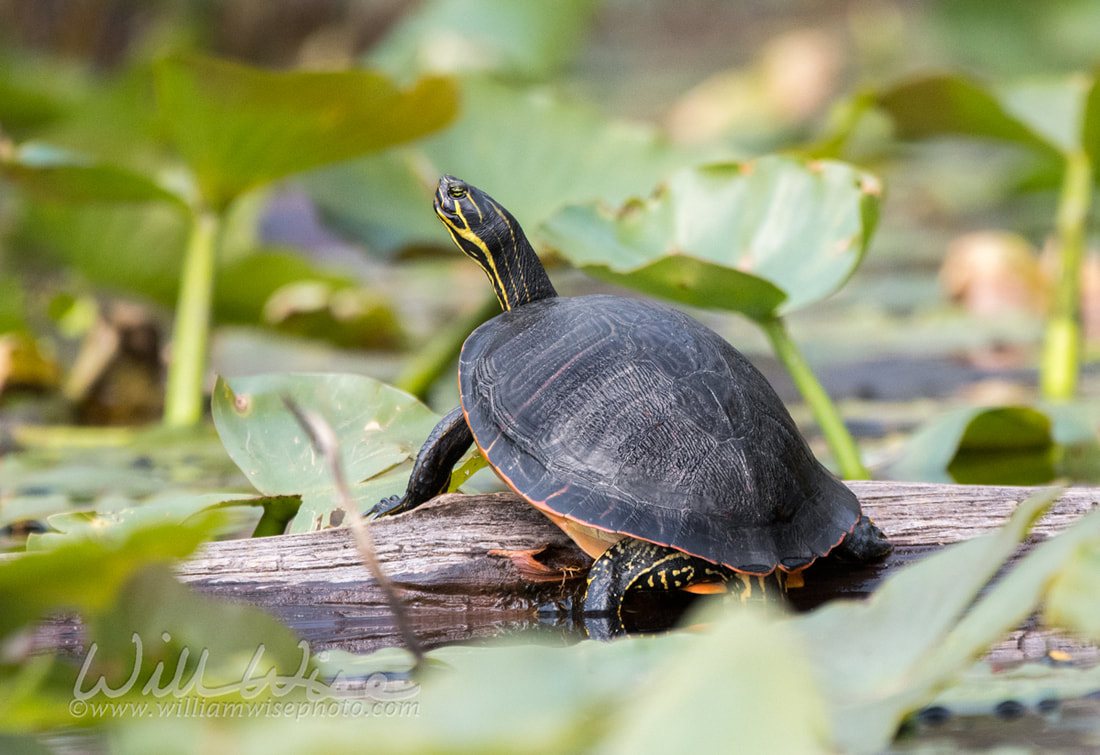
Florida River Cooter slider turtle on lily pads in the Okefenokee Swamp National Wildlife Refuge near Stephen C Foster Georgia State Park. The Coastal plain cooter, Pseudemys concinna floridana, or Florida cooter is a large freshwater turtle found in the southeastern coastal plain of the United States, from Virginia southward through Florida.
 Okefenokee Photography by William Wise. A nature photo journal exploration of Georgia's Okefenokee Swamp, the Land of Trembling Earth, one of the largest blackwater swamps in North America. The alligators, birds, snakes and wildlife of Okefenokee National Wildlife Refuge and Stephen C Foster State Park. -- "What a wildly wonderful world, God! You made it all, with Wisdom at Your side, made earth overflow with your wonderful creations." Psalms 104 The Message The Okefenokee Swamp is a gorgeous National Wildlife Refuge in the southeastern United States. The majority of its 438,000 acres lies within the state of Georgia. This refuge is a nature photographer’s delight. I'm not an Okefenokee expert, but I have visited the swamp four times and have developed a good system that worked for me. I want to share these experiences to help others maximize a delightful photo adventure. PART 2: WHEN TO OKEFENOKEEI suppose you can do the Okefenokee anytime of the year, but our trips have always been in March during my daughter’s spring break. I haven’t been there at other times (other than one day trip in January), but I know about South Georgia summers and think spring might offer a more comfortable atmosphere. The cooler late winter/early spring temperatures mean several things. One of the best things about a March visit is fewer insects! There is nothing that can put a damper on things like flies that can bite through clothes, seemingly repellent-resistant mosquitoes, and relentless gnats that always congregate near your nostrils and eyes. On our last visit in March, I only had to put on repellent in the evenings at the campground. There was little need during the day while out on the swamp. Late winter/early spring also means cool water and cool nights. Why is that good for photography? Well, as the sun climbs, the daytime temperatures begin to hit the 80’s. Those cold-blooded alligators are more than anxious to climb out of the cool water and bask in the golden rays. If you hit the lighting right, there are ample opportunities to shoot all sizes of gators laying about on the peat mats, lily pads and fallen Cypress stumps. And spring temperatures are much nicer that baking in an open canoe in August in Georgia! I don’t know when Stephen C Foster State Park’s peak season may be, but we’ve always enjoyed fewer folks and plenty of open campground spots during our March visits; especially if your stay is mid-week. Again, I haven’t stayed at Stephen C Foster in any other month, but March really has worked well for us. Perhaps others can chime in about their favorite times to Okefenokee by leaving a comment below. 
Okefenokee Photography by William Wise. A nature photo journal exploration of Georgia's Okefenokee Swamp, the Land of Trembling Earth, one of the largest blackwater swamps in North America. The alligators, birds, snakes and wildlife of Okefenokee National Wildlife Refuge and Stephen C Foster State Park. -- "What a wildly wonderful world, God! You made it all, with Wisdom at Your side, made earth overflow with your wonderful creations." Psalms 104 The Message
The Okefenokee Swamp is a gigantic and gorgeous National Wildlife Refuge in the southeastern United States. The majority of its 438,000 acres lies within the state of Georgia, but a portion stretches southward into Florida. This refuge is a nature and wildlife photographer’s delight, being full of the natural beauties of fauna and flora. I have visited the swamp four times and have developed a good system to maximize a delightful photo adventure.
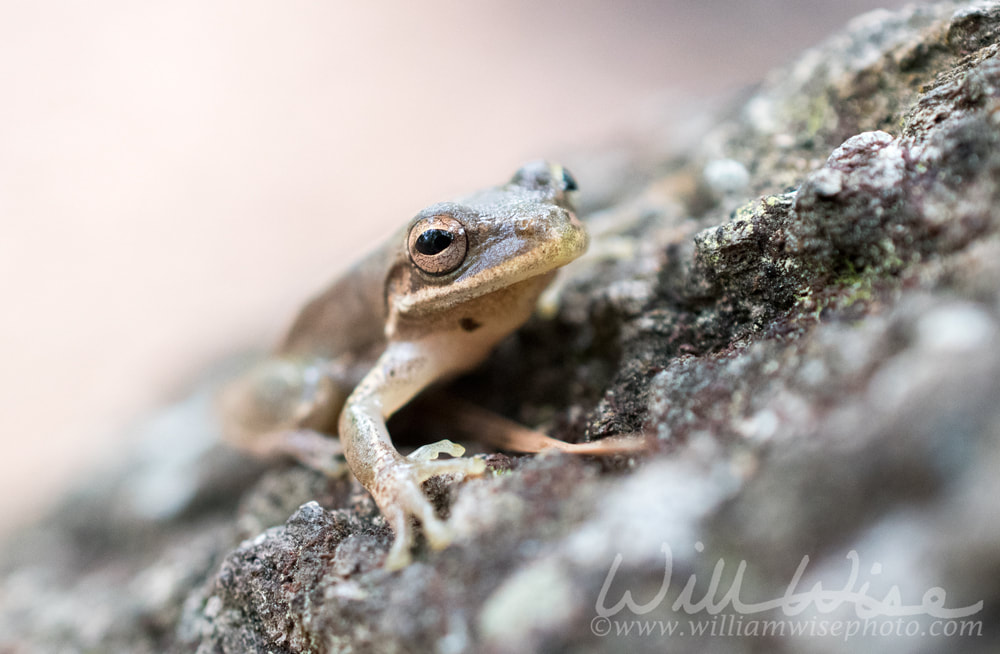
Macro photography of a Squirrel Tree Frog, Hyla squirella, climbing a tree in the Okefenokee Swamp National Wildlife Refuge, Georgia. Stephen C Foster Georgia State Park campground. Shot with 40mm macro lens. The squirrel tree frog Hyla squirella is a small species of tree frog found in the southeastern United States, from Texas to Virginia. This little frog was found under our cooler when we struck camp to leave on March 16, 2019.
pART 1: WHERE TO STAY
There are a few entrances and boat launches within the Okefenokee, but I have always used the Stephen C Foster State Park as my base of operations while paddling the swamp. Normally I prefer backcountry and wilderness treks, but if photography is your main goal, there is an advantage to “taking it easy” and staying in a campground.
ELECTRICITY!
One of the main advantages is electricity! Camera batteries die. And it seems that the newer the camera, the more quickly they die. Why? Bluetooth connections, brighter LED screens, better metering and autofocus systems… all these place a drain on the batteries. On an extended trip, your canoe might sink due to all the extra batteries you’d have to bring along! But each of the Stephen C Foster State Park’s 66 campsites have an electrical outlet. There is no need to drag along a generator or tax your vehicle’s battery when power is needed.
Returning to camp each evening, those tired cells of lithium life can be refueled! I always bring a fifty-foot extension cord and a multi-outlet surge protector. We run that cord from the RV electrical hookup right into our tent. Not only are the camera batteries recharged, but so is the cell phone. I also bring along my laptop so I can stay ahead of the workflow game and begin downloading and culling each day’s photos before even getting home. COMFORT!
I fully understand that the entire point of camping is to “rough it”. And while I still love the primitive, wilderness camping adventures, I must admit that not only does staying in the Stephen C Foster campground help recharge my camera batteries each night, but sleeping on a cot in my comfortable tent also helps revive my aging body with a better night’s sleep!
The Stephen C Foster campground also has several “comfort stations” with clean showers, restrooms and washer/dryer within each campground loop. You’ll be ready and fresh each morning for a full day’s photography of the gorgeous Okefenokee Swamp! And if you really want comfort, there are nice cabins at the park as well. SECURITY!
While staying at Stephen C Foster State Park, I’ve never had an issue with my campground being plundered while gone all day paddling the swamp. Yes, there is an unwritten code of ethics and a sense of community amongst like-minded campers, but having a campground host ever present and regular patrols from certified law enforcement park rangers helps too!
The sole entrance to the park is also gated and closed each evening. While I don’t want to temp anyone by leaving expensive camping or camera gear lying around, I have never returned to camp at night to find my propane stove or folding chairs missing.
Come back for more Okefenokee Swamp How-To Photographer's Guides!
|
Categories
All
Archives
June 2025
|
|
All content is ©williamwisephoto.com. Please don't steal images. My images are available at dreamstime.com. Stock sales go into the shelter photography program.
|
In December 1993 I came to know the Designer and Creator of this wonderful planet and its creatures: Jesus Christ.
|
Donations help support the animal shelter adoption photography equipment and adoption website hosting and domain fees. Thanks for your support!
|

